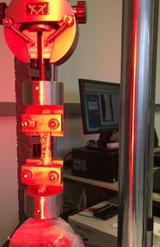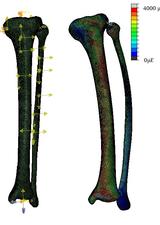
Research
Current Investigations
Ongoing projects in the lab focus on four interrelated topics including: 1) the quantification of in vivo bone loading, 2) the influence this loading has on bone mechanobiology and mechanical fatigue, 3) the non-invasive, quantitative assessment of bone mechanical integrity, and 4) the development of treatments to improve bone quality and decrease fracture risk in aging and pathological populations.
Subject-specific computational modeling techniques are a central component of our research. We use these models to non-invasively assess the mechanical competence of bone and to quantify bone stress and strain during physical activity and rehabilitation.

The Influence of Intracortical Microarchitecture on the Mechanical Fatigue Behavior of Bone
Owing to the inherent variability found in bone tissue, two samples that appear identical in macrostructure will inevitably exhibit scatter in their fatigue behaviour. This scatter can vary as much as one or even two orders of magnitude. Our central hypothesis is that this inherent scatter can be attributed to intracortical microarchitecture, including cellular and vascular density and organization. This would be an important finding because these microarchitectural parameters are a function of bone remodeling dynamics, which may be heavily influenced by physical activity and pharmaceutical therapy. By combining mechanical testing and novel imaging techniques, this research will quantify the relationship between intracortical microarchitecture and the mechanical fatigue behavior of bone and further explore the mechanisms that govern the fatigue failure of bone using finite element modeling.
Lindsay Loundagin | Kinesiology Graduate Program: PhD

Repetitive Loading and Cumulative Damage in the Human Patellar Tendon
Patellar tendinopathy is an overuse injury caused by excessive strain and is associated with the mechanical fatigue of the patellar tendon. This first study of my research combined whole body kinematics and kinetics during jumping in shoes with different midsole stiffness to estimate internal patellar tendon strains, while the second and third studies of my PhD aim to increase our understanding of how the patellar tendon behaves during fatigue loading both in terms of strain distribution and its stress-life relationship.
Colin Firminger | Biomedical Engineering Graduate Program: PhD
Email: cfirming@ucalgary.ca

Statistical shape and intensity models of the tibia-fibula complex
Computed tomography and magnetic resonance imaging are the gold standard methods for quantifying bone geometry and density to create subject-specific computational models. Computed tomography involves high levels of ionizing radiation, and both imaging techniques are time-consuming and costly. Statistical shape and intensity models, which describe the average and principal modes of variation of shape and intensity, may provide an alternative method to estimate subject-specific bone geometry and density that addresses these barriers. This research aims to build statistical shape and intensity models of the tibia-fibula complex and to assess errors associated with using these models to estimate bone geometry and density distributions from anatomical landmarks and partial medical imaging data.
Olivia Bruce | Biomedical Engineering Graduate Program: PhD
Email: olivia.bruce@ucalgary.ca

Atypical femoral fractures – Etiology and Risk Factors
Atypical femoral fracture is a category of low-energy fracture of the femoral shaft or subtrochanteric region. Though some risk factors have been identified, such as an individual’s bone geometry or history of antiresorptive medication use, the pathomechanisms and etiology of this disease are not well understood. Using medical imaging and subject-specific finite element analysis, this research seeks to identify individuals who are at greatest risk of AFF, and to understand how various risk factors contribute mechanistically towards progression of this injury.
Ifaz Haider PhD | Postdoctoral Fellow
Email: ifaz.haider@ucalgary.ca

Musculoskeletal Loading During Graded Running
Investigating how musculoskeletal tissue loading is altered by running grade in order to better understand the development of running injuries.
Michael Baggaley | Kinesiology Graduate Program: PhD
Preventing Bone loss after Spinal Cord Injury
After spinal cord injury (SCI), most individuals experience rapid and profound bone loss at sublesional locations, such as the knee, and this bone loss is associated with a high risk of fracture. Using medical imaging and subject-specific finite element simulation, this study aims to develop and assess intervention programs to help patients improve or maintain bone, and reduce fractures after SCI. This work is being done in collaboration with researchers at Northwestern University.
Ifaz Haider PhD | Postdoctoral Fellow
Email: ifaz.haider@ucalgary.ca

Repeated Bout Effect in Prolonged Downhill Running
The repeated bout effect is a well-known phenomenon in eccentric-biased exercises wherein the repetition of the same exercise bout up to a few weeks after the initial bout causes less muscle damage and soreness. This project investigates the repeated bout effect during prolonged downhill running on neuromuscular fatigue and running biomechanics. Given the high magnitude of muscle damage and fatigue during a prolonged downhill run, the second goal of this study is to investigate musculoskeletal and tissue-level loading over the course of a prolonged downhill run using medical imaging and subject-specific finite element analysis.
Arash Khassetarash | Kinesiology Graduate Program: PhD
Email: a.khassetarash@ucalgary.ca
